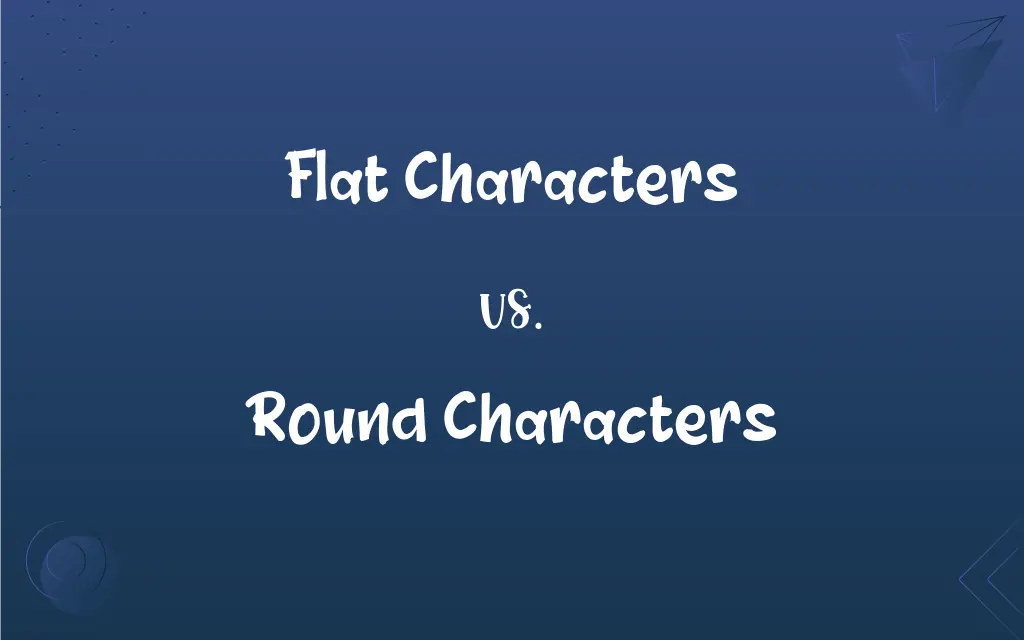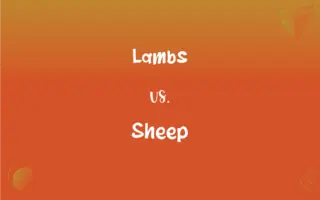Flat Characters vs. Round Characters: What's the Difference?
Edited by Aimie Carlson || By Harlon Moss || Updated on October 7, 2023
Flat characters are simplistic and unchanging, often embodying one or two qualities. Round characters are complex and dynamic, undergoing development or transformation.

Key Differences
Flat characters and round characters serve unique and essential roles in storytelling, aiding in the unfolding of plotlines and supporting main characters in their developmental arcs. While flat characters tend to be straightforward, exhibiting little to no change or complexity throughout the story, round characters showcase depth, evolution, and often, an intricate personality. The presence of both flat and round characters allows for a diversified narrative, where certain individuals (flat characters) might represent steadiness and predictability, while others (round characters) introduce dynamism and complexity. Thus, flat characters often embody stereotypical roles or represent specific ideas without providing psychological depth, while round characters draw readers in with their multi-dimensional, relatable, and evolving personas.
In literary pieces, flat characters frequently serve as tools to propel the narrative forward or to highlight specific characteristics or dilemmas of round characters. The uncomplicated nature of flat characters often provides a stable backdrop against which the more dynamic changes and complexities of round characters can be vividly contrasted and explored. Flat characters typically remain consistent in their beliefs, behaviors, and personalities throughout a story, providing a reliable constant. Conversely, round characters drive the emotional core of a narrative, generating empathy, and engagement from the audience due to their human-like flaws, growth, and varied experiences.
Both flat characters and round characters interact with and influence the primary storyline, yet they do so in distinctly different ways. While flat characters often symbolize unchanging elements and maintain singular, unwavering traits or roles throughout a narrative, round characters embody transformation, conflict resolution, and multifaceted personalities. For instance, flat characters may exemplify themes or represent particular societal roles or norms consistently, without manifesting evolution. Meanwhile, round characters undergo significant development, often learning, evolving, or shifting their perspectives, thereby providing the narrative with depth, conflict, and resolution.
Analyzing both flat characters and round characters further, we can explore their roles in highlighting themes and moral lessons within a story. Flat characters, through their consistency and simplicity, can make certain thematic elements or moral teachings starkly apparent, delivering clear and unambiguous messages to the audience. On the other hand, round characters navigate through moral and ethical dilemmas with a nuanced approach, often grappling with internal conflicts and embodying the complexity of real-life decision-making. This allows writers to explore themes and moral concepts with greater depth and realism through the experiences and evolution of round characters.
Comparison Chart
Complexity
Simple and one-dimensional.
Complex and multi-dimensional.
ADVERTISEMENT
Development
Do not undergo significant change or growth.
Experience development or transformation during the story.
Role in Plot
Often serve to move the plot forward or support main characters.
Typically central to the plot, driving the narrative forward.
Relatability
May not be easy to relate to due to lack of depth.
Often relatable due to their complexity and development.
Predictability
Predictable due to lack of complexity.
Unpredictable due to evolving nature and complexity.
Flat Characters and Round Characters Definitions
Flat Characters
Flat characters support the development of the main character(s).
The sassy best friend consistently nudged the protagonist towards bravery.
ADVERTISEMENT
Round Characters
Round characters engage the reader with their relatability and complexity.
Atticus Finch’s principled stand on justice and his loving fatherhood make him compelling.
Flat Characters
Flat characters are stereotypical and lack depth.
The wicked witch was simply mean with no apparent reason.
Round Characters
Round characters often drive the narrative forward.
Frodo Baggins’ courage and internal conflict propel the plot of The Lord of the Rings.
Flat Characters
Flat characters do not undergo personal development or growth.
The soldier remained stoic and unyielding throughout the war.
Round Characters
Round characters evolve as the story progresses.
Elizabeth Bennet’s views on love and marriage evolve in Pride and Prejudice.
Flat Characters
Flat characters are predictable and unchanging.
The grumpy old man next door always shouted at playful children.
Round Characters
Round characters exhibit a range of emotions and traits.
Harry Potter demonstrated bravery, kindness, and also moments of fear and doubt.
Flat Characters
Flat characters embody one or two traits or qualities.
The butler was consistently loyal and reserved.
Round Characters
Round characters possess depth, showing strengths and weaknesses.
Hamlet’s internal struggle reveals his vulnerability and contemplative nature.
FAQs
Can a story be effective with only flat characters?
Yes, certain stories, especially short stories or fables, might effectively use flat characters to convey a message or moral.
How do round characters enhance a narrative?
Round characters enhance a narrative by adding depth, complexity, and realism, often forming deeper emotional connections with the audience due to their relatability and development.
What defines a flat character?
A flat character is typically defined by one or two traits and does not undergo significant development.
How does a writer effectively utilize flat characters?
Writers use flat characters to support the plot, contrast with round characters, or emphasize particular traits or themes.
How can writers ensure they’re creating a round character?
Writers can create round characters by ensuring they have multiple traits, undergo character development, and have believable emotions and reactions.
Is it easier to write flat characters than round characters?
Flat characters can be easier to write due to their simplicity and lack of development, whereas round characters require a deeper understanding and development of personality, history, and transformation.
Are round characters always protagonists?
While round characters are often protagonists due to their complexity, they can also be secondary characters.
Is it possible for a round character to become flat?
While unusual, a round character might appear to become flat if their development reverses or stops, though this is not common in conventional narratives.
What is the key difference between flat and round characters?
The key difference lies in complexity and development: flat characters are simple and unchanging, while round characters are complex and undergo development.
Can the protagonist be a flat character?
Yes, in certain stories, especially parables or fables, a flat character might serve as the protagonist to convey a specific message or moral.
Can a character be both flat and round?
Characters are typically either flat or round based on their depth and development, but in some complex narratives, characters might display characteristics of both.
Can a flat character become round?
In well-developed stories, a flat character might evolve into a round character through growth and change.
Can a villain be a round character?
Absolutely. A villain can be a round character if they have depth, complexity, and undergo some form of development or change throughout the story.
Why are round characters important in storytelling?
Round characters provide depth, facilitate strong emotional connections with readers, and often drive the plot with their transformations and decisions.
Are flat characters essential in storytelling?
Flat characters are not always essential but are useful for moving the plot forward, providing contrast, and highlighting the qualities or growth of round characters.
About Author
Written by
Harlon MossHarlon is a seasoned quality moderator and accomplished content writer for Difference Wiki. An alumnus of the prestigious University of California, he earned his degree in Computer Science. Leveraging his academic background, Harlon brings a meticulous and informed perspective to his work, ensuring content accuracy and excellence.
Edited by
Aimie CarlsonAimie Carlson, holding a master's degree in English literature, is a fervent English language enthusiast. She lends her writing talents to Difference Wiki, a prominent website that specializes in comparisons, offering readers insightful analyses that both captivate and inform.































































